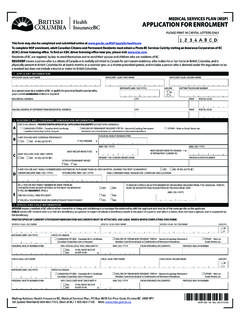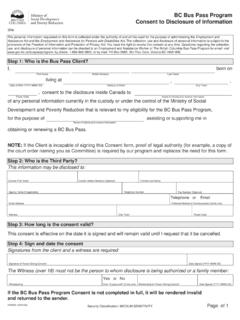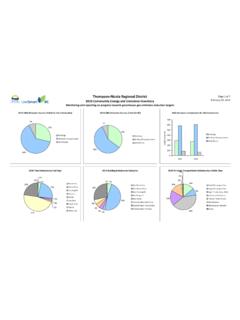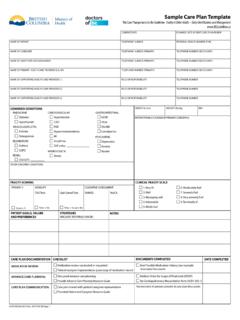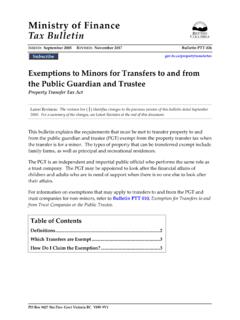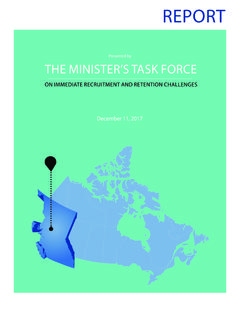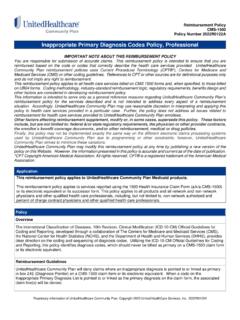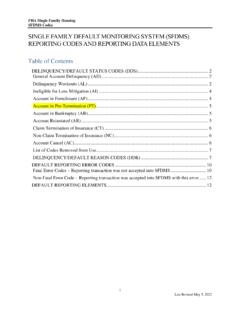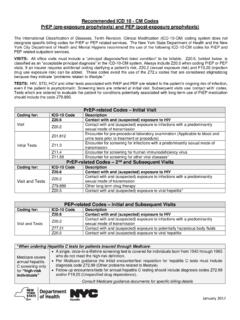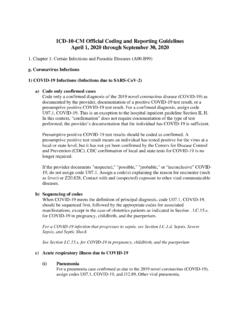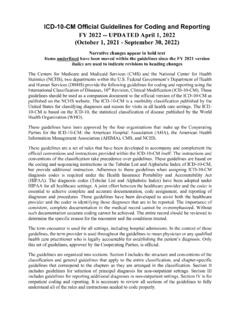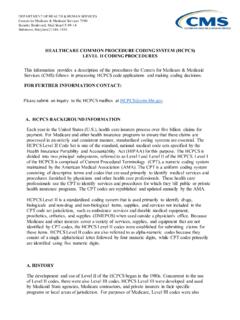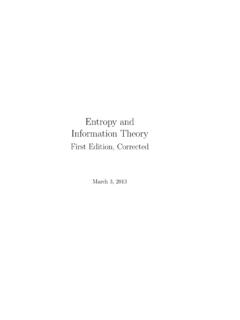Transcription of Part 9 – Housing and Small Buildings Section 9.32. Ventilation
1 Part 9 Housing and Small Buildings Section Ventilation GENERAL Application 1) This Section applies to the Ventilation of rooms and spaces in residential occupancies by natural Ventilation and to self-contained mechanical Ventilation systems serving only one dwelling unit. 2) Mechanical Ventilation systems other than self-contained systems serving single dwelling units shall conform to Part 6. 3) A storage garage for more than 5 motor vehicles shall be ventilated in accordance with Part 6. 4) Systems used for Ventilation shall conform to the energy efficiency requirements in Section Required Ventilation 1) Every dwelling unit shall incorporate a) provisions for non-heating-season Ventilation in accordance with Subsection , and b) if supplied with electrical power, provisions for heating season Ventilation in accordance with Subsection NON-HEATING-SEASON Ventilation Required Ventilation 1) Rooms or spaces in dwelling units shall be ventilated during the non-heating season by a) natural Ventilation in accordance with Article , or b) a mechanical Ventilation system conforming to Subsection November 2016 - This pdf is for information purposes only, and does not form the replacement package of the BC Building Code print product.
2 This document includes Revisions up to Revision 9, effective December 21, 2015, and reflects the text within the online BC Building Code product. 2) Where a habitable room or space is not provided with natural Ventilation as described in Clause (1)(a), mechanical Ventilation shall be provided to exhaust inside air from, or to introduce outside air to, that room or space at the rate of a) one-half air change per hour if the room or space is mechanically cooled during the non-heating season, or b) one air change per hour if it is not mechanically cooled during the non-heating season. Non-Heating-Season Natural Ventilation 1) The unobstructed openable Ventilation area to the outdoors for rooms and spaces in residential Buildings ventilated by natural means shall conform to Table Table Natural Ventilation Area Forming part of Sentence (1) Location Minimum Unobstructed Area Within a dwelling unit Bathrooms or water-closet rooms m2 Unfinished basement space of the floor area Dining rooms, living rooms, bedrooms, kitchens, combined rooms, dens, recreation rooms and all other finished rooms m2 per room or combination room Other than within a dwelling unit Bathrooms or water-closet rooms m2 per water closet Sleeping areas m2 per occupant Laundry rooms, kitchens, recreation rooms 4% of the floor area Corridors, storage rooms and other similar public rooms or spaces 2% of the floor area Unfinished basement space not used on a shared basis of the floor area 2)
3 Where a vestibule opens directly off a living or dining room within a dwelling unit, Ventilation to the outdoors for such rooms may be through the vestibule. 3) Openings for natural Ventilation other than windows shall provide protection from the weather and insects. 4) Screening shall be of corrosion-resistant material. Reserved HEATING-SEASON (MECHANICAL) Ventilation (See Appendix A.) Required Ventilation 1) Every dwelling unit that is supplied with electrical power shall be provided with a mechanical Ventilation system that conforms to a) CAN/CSA-F326-M, Residential Mechanical Ventilation Systems, or b) this Subsection. Design and Installation 1) Aspects of a mechanical Ventilation system not specifically addressed in this Subsection shall be designed, constructed and installed in accordance with good practice such as that described in the ASHRAE Handbook and standards, the HRAI Digest, the HRAI Residential Mechanical Ventilation Manual, the TECA Ventilation Guidelines, the Hydronics Institute manuals and the SMACNA manuals.
4 2) Exhaust fans and supply fans shall be installed in accordance with this Subsection and the manufacturer s instructions. 3) The mechanical components of a mechanical Ventilation system shall be installed so as to be accessible for inspection, maintenance, repair, and cleaning. Mechanical Ventilation System Components 1) A mechanical Ventilation system shall include a) a principal Ventilation system that i) provides supply air in accordance with Article , and ii) includes an exhaust fan that conforms with Article , b) the kitchen and bathroom exhaust fans that are required by Article , and c) if the building includes a heated crawl space, the components that are required by Article principal Ventilation System Supply Air (See Appendix A.) 1) Except as provided in Sentence (6), a principal Ventilation system shall mechanically provide supply air in accordance with Sentence (2), (3), (4) or (5). 2) Where the principal Ventilation system is a ducted forced-air heating system, the ducted forced-air heating system shall a) provide supply air through the ducting to i) each bedroom, and ii) each floor level without a bedroom, b) draw supply air from an outdoor inlet that is connected to the cabinet containing the furnace air circulating fan required by Clause (d) by ducting that measures, from that cabinet to the point at which the ducting intersects the return air plenum, i) between 3 m and m in length, or ii) if a flow control device is used, not more than m in length.
5 C) draw supply air through ducting that is i) rigid ducting with an equivalent diameter of at least 100 mm, or ii) flexible ducting with an equivalent diameter of at least 125 mm, and d) have a furnace air circulating fan set to run continuously. 3) Where the principal Ventilation system is a ducted forced-air heating system used in combination with a heat-recovery ventilator, a) the ducted forced-air heating system shall conform to Clauses (2)(a), (c) and (d), b) the heat-recovery ventilator shall draw supply air from an outdoor inlet into the return air plenum of the ducted forced-air heating system, and c) the heat-recovery ventilator shall draw exhaust air, through dedicated ducting, i) from one or more indoor inlets, at least one of which is located at least 2 m above the floor of the uppermost floor level, and ii) at the capacity rating of the heat-recovery ventilator, which shall be no less than the air-flow rate specified in Table 4) Where the principal Ventilation system is a heat-recovery ventilator, the heat-recovery ventilator shall a) provide supply air through dedicated ducting to i) each bedroom, and ii) each floor level without a bedroom, and b)
6 Draw exhaust air, through dedicated ducting, i) from one or more indoor inlets, at least one of which is located at least 2 m above the floor of the uppermost floor level, and ii) at the capacity rating of the heat-recovery ventilator, which shall be no less than the air-flow rate specified in Table 5) Where the principal Ventilation system is a ducted central-recirculation Ventilation system, the ducted central-recirculation Ventilation system shall a) draw supply air from an outdoor inlet connected upstream of the fan, and b) draw air from i) each bedroom and deliver it to a common area, or ii) a common area and deliver it to each bedroom. 6) A principal Ventilation system need not conform to Sentence (1) if the principal Ventilation system a) services a dwelling unit that i) is located where the January design temperature, on a basis determined in conformance with Article , is greater than 20 C, ii) has only 1 storey and a floor area of less than 168 m2 within the building envelope (see Appendix A), and iii) does not have a ducted forced-air heating system, and b) provides supply air passively from outdoors through dedicated inlets that i) are located in each bedroom and at least one common area, ii) are located at least 1 800 mm above the floor, and iii) have an unobstructed vent area of not less than 25 cm2.
7 principal Ventilation System Exhaust Fan 1) A principal Ventilation system exhaust fan shall a) run continuously, and b) provide at least the air-flow rate specified in Table Table principal Ventilation System Exhaust Fan Minimum Air-flow Rate Forming part of Sentence (1) Floor Area, m2 Minimum Air-flow Rate, L/s Number of Bedrooms 0 1 2 3 4 5 6 7 >7 < 140 14 21 28 35 42 140 280 21 28 35 42 49 281 420 28 35 42 49 56 421 560 35 42 49 56 64 561 700 42 49 56 64 71 > 700 49 56 64 71 78 2) For the purposes of Sentence (1), the capacity rating of the principal Ventilation system exhaust fan shall be determined, based on air-flow performance at 50 pa of external static pressure, in accordance with a) HVI Publication 916, Airflow Test Procedure, or b) CAN/CSA-C260-M, Rating the Performance of Residential Mechanical Ventilating Equipment. 3) The principal Ventilation system exhaust fan shall be a) designed to run continuously, and b) controlled by a dedicated switch that i) has 2 settings, on and off, ii) is located where it will be accessible for the purposes of servicing the exhaust fan but not likely to be turned off inadvertently, and iii) is clearly marked principal Ventilation EXHAUST FAN.
8 4) If the principal Ventilation system exhaust fan is designed to run at multiple air-flow rates, a) the air-flow rate of the fan shall be controlled by a switch other than the switch described in Clause (3)(b), and b) the lowest air-flow rate shall not be less than the air-flow rate specified in Table 5) The sound rating of the principal Ventilation system exhaust fan shall not exceed sone when running continuously at the air-flow rate specified in Table as determined in accordance with a) HVI Publication 915, Loudness Testing and Rating Procedure, or b) CAN/CSA-C260-M, Rating the Performance of Residential Mechanical Ventilating Equipment. Kitchen and Bathroom Exhaust Fans 1) An exhaust fan that provides at least the air-flow rate specified in Table shall be installed in a) every kitchen, and b) every bathroom or water-closet room, unless the bathroom or water-closet room is served by the principal Ventilation system exhaust fan that complies with Article 2) For the purposes of Sentence (1), the capacity rating of the exhaust fan shall be determined, based on air-flow performance at 50 pa of external static pressure, in accordance with a) HVI Publication 916, Airflow Test Procedure, or b) CAN/CSA-C260-M, Rating the Performance of Residential Mechanical Ventilating Equipment.
9 Table Kitchen/Bathroom Exhaust Fan Minimum Air-flow Rate Forming part of Sentence (1) Room Minimum Exhaust Fan Air-flow Rate, L/s Intermittent Continuous Kitchen 47 N/A Bathroom 23 9 Heated Crawl Space Ventilation 1) Where a crawl space is heated by a ducted forced-air heating system that does not draw air from the crawl space to the furnace through the return air plenum, the crawl space shall be connected to the floor space above the crawl space by at least one air-transfer grille. 2) Where a crawl space is heated other than by a ducted forced-air heating system, the crawl space shall a) be connected to i) the floor space above the crawl space by at least one air-transfer grille, and ii) the principal Ventilation system by a supply air outlet or an exhaust air inlet, b) be connected to the floor space above the crawl space by at least 2 air-transfer grilles, or c) be connected to i) the floor space above the crawl space by at least one air-transfer grille, and ii) the outdoors by a dedicated exhaust fan that complies with Sentence (4).
10 3) An air-transfer grille required by Sentence (1) or (2) shall have an unobstructed vent area of the greater of a) 25 cm2, and b) cm2 for every m2 of crawl space area. 4) Where a dedicated exhaust fan is installed in accordance with Subclause (2)(c)(ii), the dedicated exhaust fan shall a) provide an air-flow rate of at least 23 L/s, and b) be controlled by i) a humidity control device, or ii) an adjustable time control device that is capable of providing not less than 8 total hours of Ventilation per 24 hour period. 5) Where a crawl space is divided into 2 or more compartments, each heated compartment shall conform to Sentence (1) or (2). Air Ducts 1) Exhaust ducts shall discharge to the outdoors. 2) Exhaust ducts that are downstream of an exhaust fan shall have no connections to other fans or ducts. 3) Exhaust ducts, and supply ducts that conduct heated or cooled air, shall a) be sized in accordance with the requirements of the manufacturer of the fans to which they are connected, and b) have an equivalent diameter not less than that specified by Table (3).
